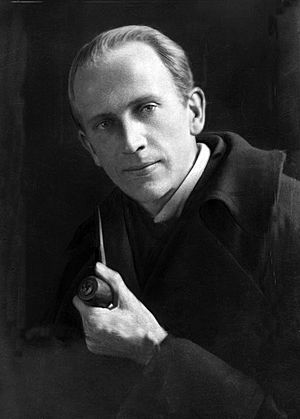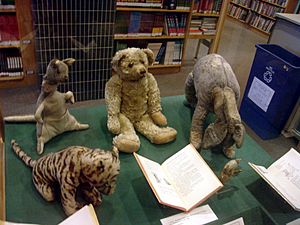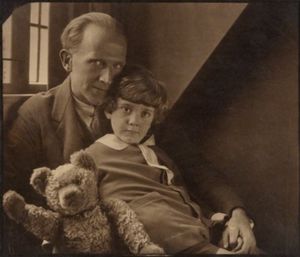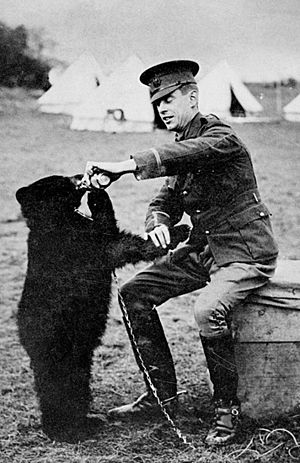A. A. Milne facts for kids
Quick facts for kids
A. A. Milne
|
|
|---|---|

A. A. Milne in 1922
|
|
| Born | Alan Alexander Milne January 18, 1882 Kilburn, London, England |
| Died | January 31, 1956 (aged 74) Hartfield, Sussex, England |
| Occupation | Novelist, playwright, poet |
| Nationality | British |
| Alma mater | Trinity College, Cambridge |
| Period | Edwardian era |
| Genre | Children's literature |
| Notable works | Winnie-the-Pooh |
| Spouse | Dorothy "Daphne" de Sélincourt (m. 1913) |
| Children | Christopher Robin Milne |
| Signature | |
 |
|
Alan Alexander Milne (born January 18, 1882 – died January 31, 1956) was an English writer. He is most famous for his wonderful books about the teddy bear Winnie the Pooh. He also wrote many plays, poems, and other stories.
Milne served in both World War I and World War II. He was a soldier in the British Army during World War I. Later, he was a captain in the British Home Guard during World War II.
Milne's son, Christopher Robin, was the real-life inspiration for the boy character in his Winnie the Pooh books.
Milne retired to his farm after a stroke in 1952. Brain surgery left him unable to move easily. He passed away on January 31, 1956, at the age of 74.
Contents
Biography

Alan Alexander Milne was born in Scotland but grew up in London, England. One of his teachers when he was a child was the famous writer H. G. Wells. Milne went to Westminster School and then to Trinity College, Cambridge. He studied mathematics there on a special scholarship.
In 1906, Milne started writing for a funny British magazine called Punch. He later became an assistant editor for the magazine.
He joined the British Army during World War I. After the war, he wrote a book called Peace with Honour (1934), where he spoke out against war. However, in 1940, at the start of World War II, he wrote War with Honour, which changed his earlier views a bit.
After Milne returned from World War I, his son, Christopher Robin Milne, was born in 1920. The two main characters in Milne's Pooh books are a boy named Christopher Robin, just like his son, and Winnie the Pooh. The name "Winnie" came from a real Canadian black bear named Winnie (Winnipeg). This bear was a mascot for soldiers and was later left at the London Zoo. Milne used his son's stuffed animals as ideas for the other characters in the books. The Hundred Acre Wood, where Pooh and his friends live, was inspired by Ashdown Forest in Sussex, England. E. H. Shepard drew the pictures for the first Pooh books.
In 1925, Milne bought a country home called Cotchford Farm in Hartfield, East Sussex. This is where he lived after brain surgery in 1952 made it hard for him to do everyday tasks.
Milne also wrote many poems. Some famous ones include "Vespers," "They're Changing Guard at Buckingham Palace," and "King John's Christmas." These poems were published in his books When We Were Very Young and Now We Are Six.
He also changed Kenneth Grahame's book The Wind in the Willows into a play called Toad of Toad Hall.
After Milne passed away in 1956, the rights to the Pooh characters were sold to the Walt Disney Company. Disney has since made many Pooh cartoon movies and a lot of toys and other items based on the characters.
Novels
- Lovers in London (1905)
- Once on a Time (1917)
- Mr. Pim Passes By (1921)
- The Red House Mystery (1921)
Non-fiction
- Peace with Honour (1934)
- It's Too Late Now (1939) (This is his autobiography, a book about his own life.)
- War with Honour (1940)
- Year In, Year Out (1952)
Story collections
- The Day's Play (1910)
- At Play (1912)
- Once a Week (1914)
- The Holiday Round (1912)
- The Sunny Side (1921)
- Gallery of Children (1925)
- Winnie the Pooh (1926)
- The House at Pooh Corner (1928)
- Those Were the Days (1929)
Poetry
- When We Were Very Young (1924)
- Now We Are Six (1927)
- Behind the Lines (1940)
- The Norman Church (1948)
Plays
Milne wrote over 25 plays, including:
- Worzel-Flummery (1917)
- Belinda (1918)
- The Boy Comes Home (1918)
- Make-Believe (1918)
- The Camberley Triangle (1919)
- Mr. Pim Passes By (1919)
- The Red Feathers (1920)
- The Romantic Age (1920)
- The Stepmother (1920)
- The Truth about Blayds (1920)
- The Dover Road (1921)
- The Lucky One (1922)
- The Artist: a Duologue (1923)
- Give Me Yesterday (1923)
- The Great Broxopp Success (1923)
- Ariadne (1924)
- The Man in the Bowler Hat (1924)
- To Have the Honour (1924)
- Portrait of a Gentleman in Slippers (1926)
- Success; a play in three acts (1926)
- Miss Marlow at Play (1927)
- The Fourth Wall or The Perfect Alibi (1928)
- The Ivory Door (1929)
- Toad of Toad Hall (1929) (This was a play based on The Wind in the Willows)
- Four Days Wonder (1933)
- Other People's Lives (1933)
- Miss Elizabeth Bennett (1936) (Based on the book Pride and Prejudice)
- Sarah Simple (1937)
- Gentleman Unknown (1938)
- The Ugly Duckling (1941) (Based on the Hans Christian Andersen story)
- Before the Flood (1951)
- Michael and Mary
A. A. Milne quotes
- "Weeds are flowers too, once you get to know them."
- "The third-rate mind is only happy when it is thinking with the majority. The second-rate mind is only happy when it is thinking with the minority. The first-rate mind is only happy when it is thinking."
- "One of the advantages of being disorderly is that one is constantly making exciting discoveries."
- "To the uneducated, an A is just three sticks."
- "You can't stay in your corner of the forest waiting for others to come to you. You have to go to them sometimes."
- "Some people care too much. I think it's called love."
- "If you live to be a hundred, I want to live to be a hundred minus one day so I never have to live without you."
Interesting facts about A. A. Milne
- The A. A. in his name stands for Alan Alexander.
- A. A. Milne earned a B.A. degree in Mathematics from Trinity College, Cambridge.
- Famous writers like J. M. Barrie (who wrote Peter Pan) and Sir Arthur Conan Doyle (who wrote Sherlock Holmes) played cricket with Milne.
- His most famous character, Winnie the Pooh, first appeared in a poem called "Teddy Bear." This poem was published in Punch magazine in 1924.
- The Hundred Acre Wood from the stories was inspired by a real forest in Sussex called Ashdown Forest.
- Eeyore, one of Christopher Robin's toys, lost some of his stuffing from being played with a lot. His head started to droop. People think this is why Eeyore has a sad personality in the stories.
- Milne's son, Christopher Robin, was teased at school because of the Pooh books. He took boxing classes to learn how to defend himself.
- A. A. Milne usually saw his son, Christopher Robin, three times a day in a formal way. A nanny (a person hired to care for children) raised Christopher Robin, which was common at that time.
Images for kids
-
A plaque remembering Milne’s birthplace in Kilburn, London.
-
In 1921, Milne bought the 18-inch Alpha Farnell teddy bear for his son from Harrods department store (pictured) in London. His son later named it Edward, then Winnie.
-
A memorial plaque for A. A. Milne and E. H. Shepard at Ashdown Forest, East Sussex. It looks out over Five Hundred Acre Wood, which was the setting for Winnie-the-Pooh.
-
This sculpture at London Zoo shows where Milne took his son Christopher Robin to see the friendly bear that inspired the story.
See also
 In Spanish: A. A. Milne para niños
In Spanish: A. A. Milne para niños








